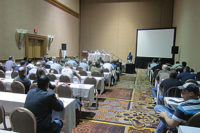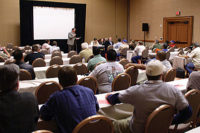• Miles Crowe, Crowe Custom Countertops, Atlanta, GA
• John Kilfoyle, United Marble Fabricators, Watertown, MA
• Mark Blanda, Stone Interiors, Loxley, AL
• Jon Lancto, Surface Products, Inc., Cornelius, NC
How do you deal with customer expectations?
Kilfoyle: Customers are doing their homework, and they are visiting five or more fabrication shops. They watch HGTV and the other home design networks, and then they think they are educated.
As a smaller shop, we are not focused on volume, so our customer interaction is detailed and thorough. We try and outline customer expectations early and often, and several key points have come up over the years: seaming issues and locations, finish quality of material, bowl cut-outs, overhangs within the sink versus flush cutouts, etc.
Crowe: Atlanta is one of the bottom three markets in the country, and we are dealing with price, but we are also setting ourselves apart so we are not competing with bottom-end prices.
The last three years were actually good for us because we didn’t owe any money, and we were able to build an inventory with a wider selection of products. So we advertise that expanded product range heavily.
As a higher-volume shop, we are doing eight to 10 kitchens per day. In order to do that volume, we are very focused on sales. We have a saying: “The answer is yes. What is the question?” But there are caveats that come with it.
We have a “What to Expect” sheet that comes with every contract. It comes from years of lessons learned and paid for. We let them know about the dust, about the hazards like someone making a hole in the sheetrock, etc. It isn’t just a legal thing, but part of customer education. We want to eliminate the chance that the customer will say, “You never told me that something like this could happen.”
The trouble comes when a salesperson promises what cannot be done. While we want to say yes to anything possible, we also have to be honest about what isn’t possible.
For shops that are doing digital templating, how do you convey the information to the shop? Is it all done onsite so that you simply e-mail a DXF file?
Lancto: We use a laser system, and it works great for us. We don’t totally clean up the drawings until they are back in the shop. We don’t e-mail them, but I am sure that capability is out there.
Crowe: We use the Prodim Proliner, and we do all of our work in the house. We require the customer to sign off on the template drawing at the time of templating. They also sign off on any radius, overhang, etc.
How are shops handling some of these larger slab islands? Is there anything that can be done beyond renting the equipment that can lift them?
Crowe: Because customers are more educated, they know their choices more. They know that they can ultimately find someone who will do that island without a seam, so we are using three-man crews.
Blanda: We use two-man crews, but with jobs like that, we will have two crews join up. The dead lift is the toughest part. We will take a 60- x 120-inch island, put it on a sheetrock dolly at the shop and use ramps to get it into the house. That way, you’re not dead lifting directly off of an A-frame.
Lancto: Most of our injuries come on install, as opposed to within the shop. There are some new products out there to help keep our employees healthy and safe. Some of them are right here [at StonExpo/Marmomacc Americas].
Blanda: In years past, we could pick and choose the jobs that we wanted to do, but now someone else will be willing to go with no seams. The slabs that are out there are larger now, and that’s what people want.
How are shops doing their sinkhole cutouts without digital equipment?
Kilfoyle: In 2005, we bought a Northwood CNC for doing our sink cutouts, and we also went to a 100% wet shop. We are using the CNC for cutouts as well as coring of faucet holes and rough profiling.
Crowe: We are also using a CNC as well as a SawJet during the process. It is rare that we are doing one by hand. We are seeing less and less [mid-range] shops. They either seem to be automated shops, or smaller hand shops.
Blanda: Our sink cutouts are done by hand. We use wet saws to rough them out. Sometimes we use the radial arm machine.
Lancto: We have been using a SawJet for a year, but we used a hydraulic router before that. The noise was bad, and our tool life was short.
There are some smaller CNCs out there; even a used one is something to look into, just in terms of efficiency.
How many shops are using layout/nesting software?
Crowe: We invested in Slabsmith layout software, and we use it to lay out every exotic job. You can’t just let your customer say, “Use your best judgment.” Rather, you need to help your customer make educated decisions, with the customer making the final decision.
Lancto: We also use Slabsmith, and it has worked very well for us. But sometimes people reject jobs for reasons beyond imagination. We did an onyx vanity, and we used Slabsmith to show the veining, cutout, etc. We sent high-res images of the template over the slab in advance, and they were approved. Then when the job was done, the customer still rejected it.
So how do you avoid jobs being rejected?
Crowe: In smaller shops, the owner is working with the customer the whole way. In larger shops, you need to have a set of processes in place to follow when guiding a project. Then in cases where there is a problem, you can see where the process wasn’t followed.
Kilfoyle: We even have processes in our small shop. It might be good for shops of any size to see how large shops are structured and how you can incorporate some of that into your own shop.
How are salespeople paid?
Crowe: We used to have outside salespeople, and we paid them straight commission. We are now doing Internet advertising, and we have an inside sales staff. They are paid a salary versus a quota, with commission on what they sell above the quota. That way, we still keep them on office hours, and they are also motivated.
Blanda: You need to define salespeople versus order-takers. We have people on salary, but then there are incentives if they sell an upgrade, such as a sink, sealer or faucets, etc.
Lancto: For us, it really depends on the segment being serviced. We created Key Performance Indicators -- activities that directly lead to a sale. On the residential side, there is the number of jobs estimated. For business-to-business, it is the number of face-to-face sales meetings.
We know that if those activities are taking place, a certain percentage of sales should come through.
How much customer hand-holding is necessary?
Blanda: You have to watch out for what we call the “WalMart Mentality,” where if a customer doesn’t like something, they think they can simply bring it back. Those customers are looking for “perfection or return.”
Crowe: When you’ve done everything right and the customer still complains, it isn’t fair, but it is part of our business. We just have to include that into your whole business equation. You can pay $3,000 to sue someone in order to get $1,500, but what does that do?
Kilfoyle: Most of our business is generated through our showroom, and when you get that call of complaint three weeks after install, you can know the type of person who does that, and you can identify the problem customers.
Crowe: I agree, and you need to identify those customers before you cut because you won’t win. Some of these Internet customers are the same people who go to the Big Boxes, and then maybe go to 10 different places to pit one guy against the other.
Lancto: You also need to remember that at the Big Boxes, the customer pays for the entire job, so they are protected. You may not be able to get the customer to pay 100% up front, but you need to at least get 50%.
Crowe: We also take 50% of each retail job up front, and then after install, we try not to leave the house without the check. They may point things out about the job, and you try to remedy them, but you still want to get paid.
Filing a lien might be effective, and Small Claims Court might work where we are in Georgia, but you are better off not leaving without a check. We try to pursue a reasonable solution, but of course we also know when we have to walk away.
In that case, do your installers carry an invoice? That would mean that the invoice price is set without knowing how many hours were spent on the install.
Crowe: We sell by the square foot, and it is not broken out by install time. So if we are doing a job at $70 per square foot and it is 50 feet, we know that the final price is $3,500 even if it takes five hours to install.
We also make sure that the customer is present when we finish, and they don’t play the game of leaving five minutes before the job is done. It’s not necessarily a matter of that they don’t want to pay, but fear that once they pay, they have no recourse.
Lancto: We did an analysis, and we found that many customers said the reason they weren’t able to pay was that they didn’t realize that a check or a credit card was needed at the time of install. Now we place a call the day before reminding them to have payment ready, and it reduced that particular problem by 75%.
Blanda: We have found that taking digital photos is also effective. That way, if the next contractor that comes in damages the countertop, you have photographic proof that it was good at the time of install. Plus, the photos are good to hang in our showroom.
How are you paying your installers?
Kilfoyle: We’ve been fortunate to have the same installer since 1987, and we pay him hourly.
Crowe: We tried paying hourly, and we’ve tried paying by the square foot. For us, the hourly rate is the one that works best for us. There is so much hand-holding for our retail installations, that it just makes more sense to pay hourly.
Lancto: For our in-house installers, we pay by the hour. If it is an outside installer, we pay by the foot; this tends to be our new commercial work.









